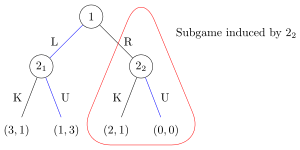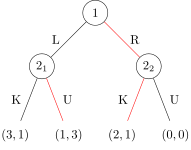Subgame perfect equilibrium
| Subgame Perfect Equilibrium | |
|---|---|
| A solution concept in game theory | |
| Relationship | |
| Subset of | Nash equilibrium |
| Intersects with | Evolutionarily stable strategy |
| Significance | |
| Proposed by | Reinhard Selten |
| Used for | Extensive form games |
| Example | Ultimatum game |
In game theory, a subgame perfect equilibrium (or subgame perfect Nash equilibrium) is a refinement of a Nash equilibrium used in dynamic games. A strategy profile is a subgame perfect equilibrium if it represents a Nash equilibrium of every subgame of the original game. Informally, this means that if the players played any smaller game that consisted of only one part of the larger game, their behavior would represent a Nash equilibrium of that smaller game. Every finite extensive game has a subgame perfect equilibrium.[1]
A common method for determining subgame perfect equilibria in the case of a finite game is backward induction. Here one first considers the last actions of the game and determines which actions the final mover should take in each possible circumstance to maximize his/her utility. One then supposes that the last actor will do these actions, and considers the second to last actions, again choosing those that maximize that actor's utility. This process continues until one reaches the first move of the game. The strategies which remain are the set of all subgame perfect equilibria for finite-horizon extensive games of perfect information.[1] However, backward induction cannot be applied to games of imperfect or incomplete information because this entails cutting through non-singleton information sets.
A subgame perfect equilibrium necessarily satisfies the One-Shot deviation principle.
The set of subgame perfect equilibria for a given game is always a subset of the set of Nash equilibria for that game. In some cases the sets can be identical.
The Ultimatum game provides an intuitive example of a game with fewer subgame perfect equilibria than Nash equilibria.
Example
An example for a game possessing an ordinary Nash equilibrium and a subgame perfect equilibrium is shown in Figure 1. The strategies for player 1 are given by whereas player 2 has the choice between as his choice to be kind or unkind to player 1 might depend on the choice previously made by player 1.



The payoff matrix of the game is shown in Table 1. Observe that there are two different Nash equilibria: given by the strategy profiles and . Consider the equilibrium given by the strategy profile (shown in the middle). Observe that while the profile is obviously a Nash equilibrium, the behaviour of player 2 is rather hard to justify when we look at his choice at the node : By choosing strategy instead of player 2 would increase his profit if node would actually be reached during the progress of the game. More formally, the equilibrium is not an equilibrium with respect to the subgame induced by node . It is likely that in real life player 2 would choose the strategy instead which would in turn inspire player 1 to change his strategy to . The resulting profile (shown on the right) is not only a Nash equilibrium but it is also an equilibrium in all subgames (induced by the nodes resp ). It is therefore a subgame perfect equilibrium.
| (K, K) | (K, U) | (U, U) | (U, K) | |
|---|---|---|---|---|
| L | (3, 1) | (3, 1) | (1, 3) | (1, 3) |
| R | (2, 1) | (0, 0) | (0, 0) | (2, 1) |
Finding subgame-perfect equilibria

Reinhard Selten proved that any game which can be broken into "sub-games" containing a sub-set of all the available choices in the main game will have a subgame perfect Nash Equilibrium strategy (possibly as a mixed strategy giving non-deterministic sub-game decisions). Subgame perfection is only used with games of complete information. Subgame perfection can be used with extensive form games of complete but imperfect information.
The subgame-perfect Nash equilibrium is normally deduced by "backward induction" from the various ultimate outcomes of the game, eliminating branches which would involve any player making a move that is not credible (because it is not optimal) from that node. One game in which the backward induction solution is well known is tic-tac-toe, but in theory even Go has such an optimum strategy for all players.
The interesting aspect of the word "credible" in the preceding paragraph is that taken as a whole (disregarding the irreversibility of reaching sub-games) strategies exist which are superior to subgame perfect strategies, but which are not credible in the sense that a threat to carry them out will harm the player making the threat and prevent that combination of strategies. For instance in the game of "chicken" if one player has the option of ripping the steering wheel from their car they should always take it because it leads to a "sub game" in which their rational opponent is precluded from doing the same thing (and killing them both). The wheel-ripper will always win the game (making his opponent swerve away), and the opponent's threat to suicidally follow suit is not credible.
See also
- Retrograde analysis
- Centipede game
- Solution concept
- Glossary of game theory
- Dynamic inconsistency
- Minimax theorem
References
External links
- Example of Extensive Form Games with imperfect information
- Java applet to find a subgame perfect Nash Equilibrium solution for an extensive form game from gametheory.net.